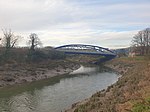Bristol Jamia Mosque
1968 establishments in EnglandBarelvi mosquesBristol building and structure stubsEuropean mosque stubsMosque buildings with domes ... and 6 more
Mosques completed in 1968Mosques converted from churches in EuropeMosques in EnglandOrganisations based in BristolReligious buildings and structures in BristolUnited Kingdom religious building and structure stubs

The Bristol Jamia Mosque is a mosque in the Totterdown area of Bristol. It was the first mosque in Bristol and is currently the largest in the south west of England. The building was formerly a disused church that was bought and converted into a mosque in 1968. It has since been embellished with a dome and minaret.
Excerpt from the Wikipedia article Bristol Jamia Mosque (License: CC BY-SA 3.0, Authors, Images).Bristol Jamia Mosque
Pylle Hill Crescent, Bristol Totterdown
Geographical coordinates (GPS) Address Nearby Places Show on map
Geographical coordinates (GPS)
| Latitude | Longitude |
|---|---|
| N 51.44213 ° | E -2.58195 ° |
Address
Pylle Hill Crescent 4
BS3 4TZ Bristol, Totterdown
England, United Kingdom
Open on Google Maps









